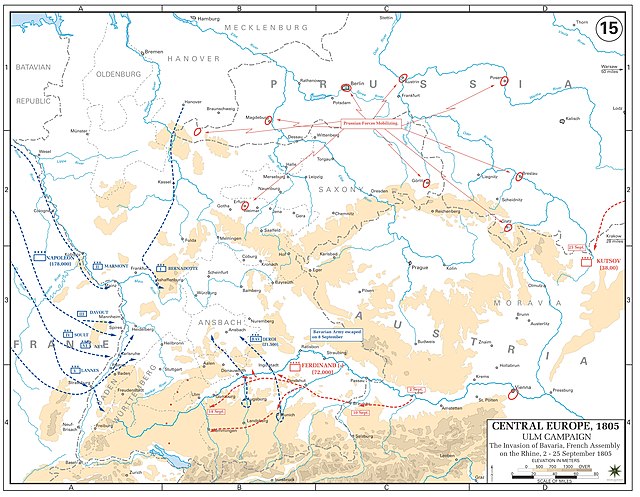The Ulm campaign was a series of French and Bavarian military maneuvers and battles to outflank and capture an Austrian army in 1805 during the War of the Third Coalition. It took place in the vicinity of and inside the Swabian city of Ulm. The French Grande Armée, led by Napoleon, had 210,000 troops organized into seven corps and hoped to knock out the Austrian army in the Danube before Russian reinforcements could arrive. Rapid marching let Napoleon conduct a large wheeling maneuver, which captured an Austrian army of 23,000 under General Mack on 20 October at Ulm. That brought the total number of Austrian prisoners-of-war in the campaign to 60,000. The campaign is by some military historians regarded as a strategic masterpiece and was influential in the development of the Schlieffen Plan in the late 19th century. Napoleon himself wrote:four months of marching about, months of fatigue and wretchedness, have proved to me that nothing is more hideous, more miserable, than war. And yet our sufferings in the Guard are not to be compared with those of the line.

The Capitulation of Ulm, a romanticised painting by Charles Thévenin
European strategic situation in 1805 before the start of the Ulm campaign
The French concentrated around the Rhine from early to mid-September. 210,000 troops of the Grande Armée prepared to cross into Germany and encircle the Austrians.
The French invasion in late September and early October caught the Austrians unprepared and severed their lines of communication.
Archduke Ferdinand Karl Joseph of Austria-Este
Archduke Ferdinand Karl Joseph of Austria-Este was the third son of Archduke Ferdinand of Austria-Este and of his wife Princess Maria Beatrice Ricciarda d'Este, last member and heiress of the House of Este. For much of the Napoleonic Wars he was in command of the Austrian army.
lithography by Joseph Kriehuber, 1841





